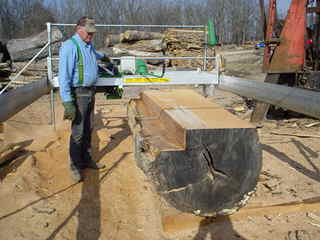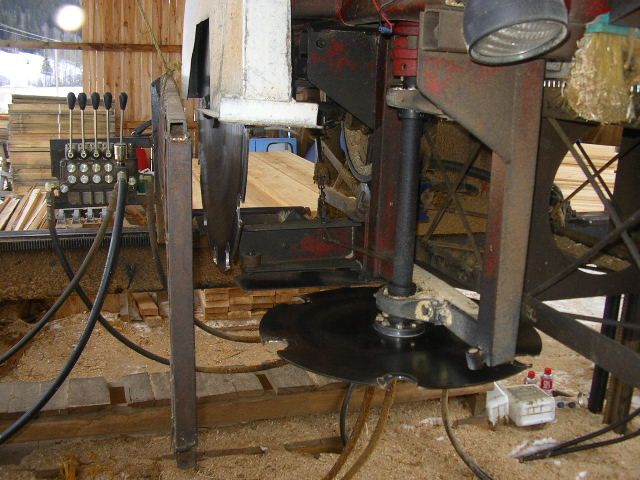Quarter-sawing on a Swing-Blade Mill
Quarter-sawing problems, solutions, and ideas. August 31, 2009
Question
Can someone explain to me how you quarter saw on the Lucas mill?
Forum Responses
(Sawing and Drying Forum)
From contributor A:
Take off the top slab, then cut vertical back and forth a few times, then drop as deep as you can and saw horizontally. It will let go of three or four boards at a time. You will produce rift and qsawn boards. In the middle section of the log you will go back to sawing horizontally, which will produce qsawn lumber. Then back to sawing vertically and you will finish up the log. It works great but you can not saw up the pies very well, so you will produce some flat and rift sawn lumber. You are also limited to the depth of cut for the width of boards.

From contributor T:
I have never done this before, but thinking about it I can see breaking the log into quarters with a large chainsaw, and holding the quartered piece with some sort of V-shaped jig helping greatly.
From contributor M:
I have a Mighty Mite twin blade circular and qsaw a lot. You can get edge grain from the top, bottom and both sides. If you are sawing more than one size, you can get edge grain from the "corners" or pies. As an example, if you are going for 2x6 from a 20" log, then you get 12 vg boards and some 1x3 and 1x4 in the corners that are also vg. There will be 3 boards from the center of the log that won't matter how you saw them because they will be full of knots. The real key is whether the extra time it takes to max out the VG content is worth it, or do you settle for 75% VG and saw twice as fast by cutting 2x4ís from the corners rather than 1x3 and 1x4.

Click here for higher quality, full size image
From contributor S:
I always try to cut parallel to the bark to get the best quarter sawn and take the taper out of the center of the log. This requires a tapered section to be taken out of the center of the log by adjusting one winch down and the other winch slightly up. I also slide one end frame toward the other side of the log on the exit cuts to again establish parallel to the bark. You have to readjust after each layer of log is removed to reestablish parallel to the bark. On larger logs, 24"+, when to side shift depends on the quality of the log. Best q sawn is at 12 o'clock, so try not to do it there.
From contributor P:
I'd like to try something that I haven't seen described here yet: rotating the log as you would eat an ear of corn, essentially lag bolting on some pipe flanges centered on the ends of the log. This would allow for 12 o'clock (radial) sawing for each board.
I'm planning on making relatively narrow boards of 5" or so for trim starting from 36Ē d logs. I'm not concerned with the waste and was considering drying the slightly pie shaped boards as they were, since molded trim often has a thick edge. Has this been tried? Any advice before I over invest in this idea?
Secondly, a Lucas mill would be my first choice, but I don't have a sawyer with a Lucas close. My second choice would be to rig my gantry crane with a 14" 40 tooth carbide rip blade on a 7.5 hp 3ph saw motor. The motor and saw would conceivably be a head from a 700 pound 16" DeWalt radial arm saw. Alternately, the motor could be from a 1000 pound Monarch 18Ē direct drive table saw. I'm not sure how the green wood would rip with the conventional rip saw. I'm not convinced that the motor would operate under continuous duty even though the rip blade is smaller than the motorís maximum capacity. I donít know the rate that I could saw at. I may have to make two passes to get the 5Ē depth Iím looking for. I'm only looking to do a few logs a year on this setup. Iíd be happy if I could cut a 600 bdft log in one day. Thoughts?
From contributor J:
I friend of mine does what you're talking about with maple for fiddles. I mean the shafts in the end of the logs. It works great for him. You also might try someone with a Peterson mill.
From contributor P:
Thanks for the encouragement. How big are the logs on your friend's rotisserie? Would he/she be willing to share any experience with attachment of the shafts, bearings, supporting the log, and rotating precisely?
From contributor J:
You know, I never really paid too much attention on how he did it. He sold the mill last year. I really do not think it would be too hard to do.
From contributor P:
I'd still like some feedback on my underpowered electric motor and rip saw for cutting up a log or two a year. The blade wasn't described accurately above. It is actually a 30 tooth carbide blade 14" diameter with a 0.157" kerf.
From contributor A:
You could make plates and bolt them onto the ends of the log. Then make a support for it to rest on and then be able to spin the log. Large logs would be a bear to handle. The trick would be cutting the cuts loose once they were made (you have to saw the bottom edge off). My thinking is it would be more work than the production could justify.
As for a saw blade on a crane, it would seem hard for me to get it to track down the log true enough to make a good board.
From contributor P:
Thanks. I've gotten a couple ideas on freeing the wedges which may work (one is a swing blade cutting them loose on the return trip, the other is cutting the wedges deep enough and with a wide enough kerf that they free themselves or split out easily).
Accuracy and repeatability of tracking on a girder or bridge crane is something I'm struggling with. The crane wasn't made for repeatable travel and needs to be tightened up to use for this purpose.

